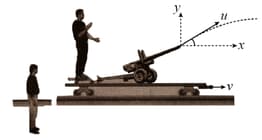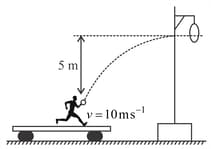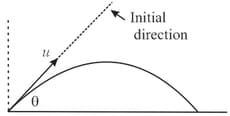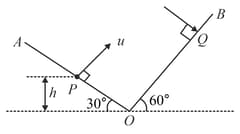A boy throws a ball in air at to the horizontal along a road with a speed of . Another boy sitting in a passing car observes the ball. Sketch the motion of the ball as observed by the boy in the car, if the car has a speed of . Give explanation to support your diagram.

Important Questions on Kinematics II
(a) Find the total displacement of the coin relative to the ground till it comes to the hand of the boy.
(b) What is the maximum height attained by the coin w.r.t to ground?
A shell is projected from a gun with a muzzle velocity, . The gun is fitted with a trolley car at an angle as shown in the figure. If the trolley car is made to move with constant velocity towards right, find the
(a) horizontal range of the shell relative to ground.
(b) horizontal range of the shell relative to a person travelling with trolley.

A man is standing on a rail road car travelling with a constant speed of (figure). He wishes to throw a ball through a stationary hoop above the height of his hands in such a manner that the ball will move horizontally as it passes through the hoop. He throws the ball with a speed of with respect to himself.

(a) What must be the vertical component of the initial velocity of the ball?
(b) How many seconds after he releases the ball will it pass through the hoop?
(c) At what horizontal distance in front of the loop must he release the ball?
A man is sitting in an open car which is travelling along a road at a speed of . The man stands up and throws a ball at a speed of relative to himself at an angle to the horizontal. The moment the man throws the ball, the driver of the car begins to accelerate at a constant rate of , in the direction in which it was initially travelling.
(a) Find the value of if the man in the car catches the ball.
(b) Find the time at which the man catches the ball if the instant at which the ball was thrown is .
Assume that the time at which the ball travels contains the line of the motion of the car and that .
A particle is projected with velocity at angle with horizontal. Calculate the time when it is moving perpendicular to initial direction. Also calculate the velocity at this position.

Two inclined planes and having inclination (with horizontal) and , respectively, intersect each other at as shown in the figure. A particle is projected from point with velocity along a direction perpendicular to plane . If the particle strikes plane perpendicularly at , calculate the

(a) velocity with which the particle strikes the plane .
(b) time of flight.
(c) vertical height of from .
(d) maximum height from , attained by the particle.
(e) distance .
